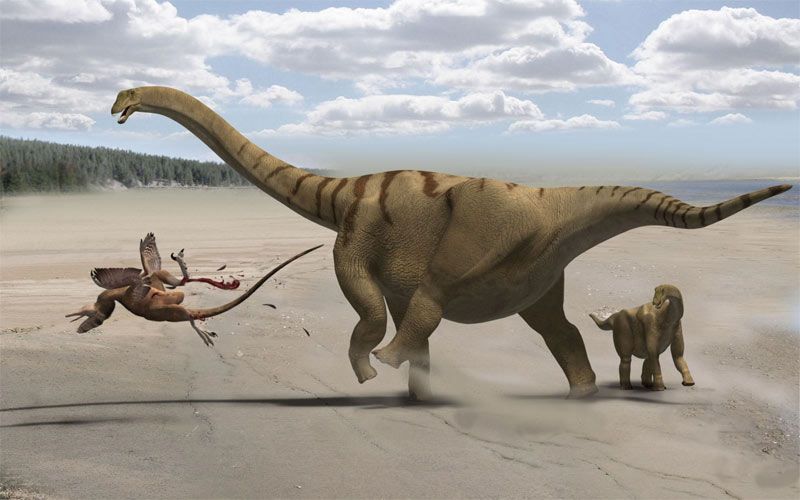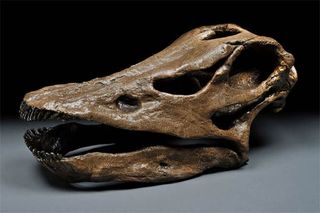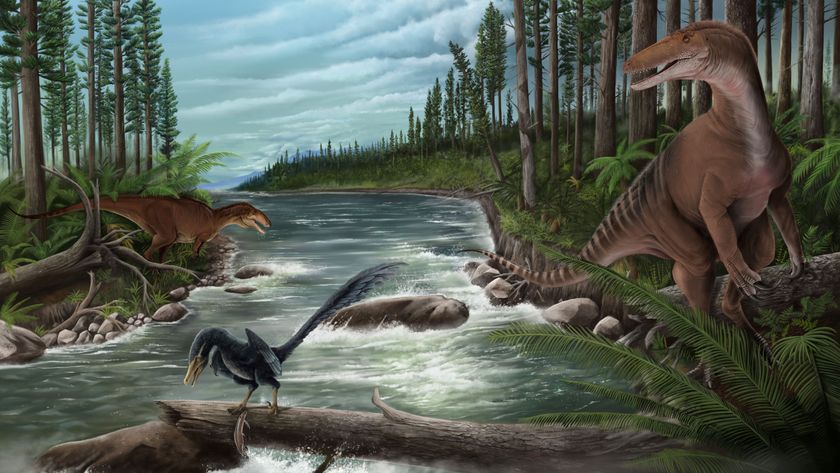How Dinosaurs Got So Huge

Among dinosaurs, the biggest of the big is Argentinosaurus. This long-necked, puny-headed creature is a member of a group of giants called sauropods. This particular extinct creature measured as much as 140 feet (43 meters) long and weighed up to 90 tons (82 metric tons).
Beyond inspiring awe, a creature of these proportions inspires all sorts of questions: Why and how did these dinosaurs, which started out relatively small, become so big? How did they feed and maintain their large bodies? A new exhibit at the American Museum of Natural History in New York City explores the mysteries surrounding their enormity.
The exhibit is dominated by a model of Mamenchisaurus, a smaller relative to Argentinosaurus. The skin is peeled back on half of the model to allow a peek into the animal's physiology. On the left side of the abdomen, projected images show body processes, such as the path of fresh air into the lungs and a birdlike system of air-storage sacs.
Large sauropods needed more air and more food than smaller creatures. A young adult Mamenchisaurus, for example, needed to consume 100,000 calories a day to maintain itself. This nutrition came from leaves and other plant material they snipped and stripped before gulping their meal down.
The long neck — for Mamenchisaurus it was 30 feet (9 meters) — made their enormous body size workable, allowing them to the reach to feed themselves efficiently. Sauropods used their necks to reach food without moving their more lumbering bodies. And in turn, the long neck — itself very light — was possible because of the dinosaur's small head, with the largest of sauropod brains weighing only 4 ounces (113 grams) as compared with the 48-ounce (1.4 kilograms) human brain.

The sauropod habit of gulping down its dinner is also crucial, according to P. Martin Sander, a co-curator of the exhibit and professor of vertebrate paleontology at the University of Bonn.
"Chewing limits body size," Sander said, explaining that animals that rely on chewing, like many mammals, depend on big molars and muscles to grind up their food to make nutrients available. As an animal gets larger, it needs progressively more energy, and eventually this cumbersome system can't provide it with enough calories.
Sign up for the Live Science daily newsletter now
Get the world’s most fascinating discoveries delivered straight to your inbox.
Sauropods, meanwhile, had teeth, but they did not chew. The earliest sauropods had spoon-shaped teeth that made for a powerful bite, and later, some evolved pencil-tip-shaped teeth that functioned like rakes, stripping away leaves and needles from trees.
Another factor has kept mammals from reaching sauropod size: reproduction. Sauropods could lay 150 eggs in a year, making them more capable of bouncing back from a given catastrophe than mammals, which invest much more in fewer offspring. This means sauropods could exist at a much lower density in a given area than mammals without being wiped out, according to Sander. Lower density living makes larger body size possible because each individual has access to more resources.
"It's pretty clear what the limiting factors are in body size, that's what we've learned from studying dinosaurs," he said.
Even sauropods did not reach the theoretical maximum for size for land animals, which has been estimated at 150 to 200 tons, Sander said.
Baby sauropods did not start out large. They emerged from eggs smaller than a soccer ball and grew at astonishing rates of up to 12 pounds (5.4 kg) per day, according to Michael Novacek, a senior vice president at the museum. This rapid growth rate implies a high rate of metabolism, and therefore, warm- bloodedness, for at least a period during the sauropods' life span, according to Novacek.
There is no question that sauropods were successful: They walked the Earth for 140 million years.
Exhibit Details:
The World's Largest Dinosaurs April 16, 2011 through Jan. 2, 2012 American Museum of Natural History in New York City http://www.amnh.org/
You can follow Live Science writer Wynne Parry on Twitter @Wynne_Parry.












